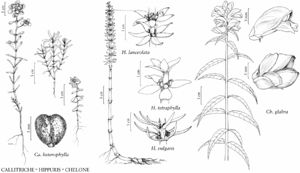Difference between revisions of "Callitriche heterophylla"
Fl. Amer. Sept. 1: 3. 1813.
FNA>Volume Importer |
imported>Volume Importer |
||
| Line 71: | Line 71: | ||
|publication year=1813 | |publication year=1813 | ||
|special status=Illustrated | |special status=Illustrated | ||
| − | |source xml=https:// | + | |source xml=https://bibilujan@bitbucket.org/aafc-mbb/fna-data-curation.git/src/bb6b7e3a7de7d3b7888a1ad48c7fd8f5c722d8d6/coarse_grained_fna_xml/V17/V17_155.xml |
|genus=Callitriche | |genus=Callitriche | ||
|species=Callitriche heterophylla | |species=Callitriche heterophylla | ||
Revision as of 20:23, 27 May 2020
Leaves connate at base, ± linear, tapering from near base or spatulate, 3.7–24.7 × 0.3–3.5 mm, 1+-veined. Stem and leaf scales present. Inflorescences: bracts caducous. Pedicels 0 mm in fruit. Flowers usually solitary; styles erect or spreading; pollen yellow. Schizocarps ± round, (0.4–)0.5–0.9(–1.2) × 0.5–1(–1.2) mm, as long as wide; mericarps black, not swollen, not winged or winged only at apex, wings straight, 0.05–0.1 mm wide.
Phenology: Flowering Feb–Nov.
Habitat: Fast-flowing streams, backwaters, ditches, swamps, Sphagnum bogs, lakes, ponds, springs, seepages, seasonally damp soils in shade.
Elevation: 0–3000 m.
Distribution
Greenland, Alta., B.C., Man., N.B., Nfld. and Labr. (Nfld.), N.S., Ont., Que., Yukon, Ala., Alaska, Ariz., Ark., Calif., Conn., Del., Fla., Ga., Idaho, Ill., Ind., Iowa, Kans., Ky., La., Maine, Md., Mass., Miss., Mo., Mont., Nev., N.H., N.J., N.Mex., N.Y., N.C., Ohio, Okla., Oreg., Pa., R.I., S.C., Tenn., Tex., Vt., Va., Wash., Wis., Mexico, West Indies (Antilles), Central America, South America, introduced in Pacific Islands (New Zealand).
Discussion
Two varieties have been recognized in Callitriche heterophylla, with var. bolanderi distinguished on the basis of its schizocarps being larger (for example, N. C. Fassett 1951b); however, the size of the schizocarps overlaps widely, and measurements of schizocarps from throughout North America show that there is no clear geographical or ecological separation between plants with smaller fruit and those with larger fruit. Therefore, there is no justification for maintaining the distinction.
Populations of small plants with linear leaves from parts of Canada and Alaska have been separated as Callitriche anceps. However, these appear to represent the lower extremes of variation in C. heterophylla, and morphological characters do not justify maintaining the distinction.
Selected References
None.
